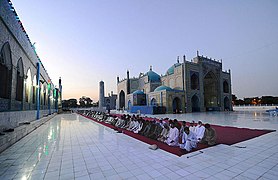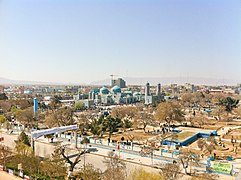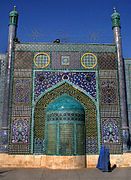Hazrat Ali Mazar
| Hazrat Ali Mazar | |
|---|---|
Rawze-e-Sharif | |
 Hazrat Ali Mazar in 2012 | |
| Religion | |
| Affiliation | Sunni Islam |
| Province | Balkh Province |
| Rite | Muslims |
| Festival | Nowruz |
| Ecclesiastical or organizational status | Mosque and Shrine |
| Status | Built |
| Location | |
| Location | Mazar, Balkh |
 Location in Afghanistan | |
| Territory | Afghanistan |
| Geographic coordinates | 36°42′30″N 67°06′40″E / 36.70833°N 67.11111°ECoordinates: 36°42′30″N 67°06′40″E / 36.70833°N 67.11111°E |
| Architecture | |
| Type | Mosque |
| Style | Islamic |
| Completed | 1481 |
The Hazrat Ali Mazar (Arabic: حضرت علی مزار), located in Mazar-i-Sharif, Afghanistan, is a mosque which Sunni Muslims believe contains the tomb of Ali ibn Abi Talib. Sunnis regard Ali as their Fourth Rightly Guided Caliph and they pay tribute to Ali's shrine every year.
The site is also where many pilgrims annually celebrate Nowruz. At the annual Jahenda Bala ceremony, a holy flag is raised in honour of Hazrat Ali. People touch the flag for luck in the New Year.[1][2]
History[]
When Hazrat Ali was martyred, Afghans believed that his body was taken and buried in the Afghan city of Mazar-e-Sharif at this site.[3] Ali was reportedly brought here by a white camel in order to save his remains from the desecration by his enemies. However, Shia Muslims believe that Hazrat Ali is buried in the Imam Ali Mosque at Najaf in Iraq. Alternatively, the personage buried in the shrine may have predated Islam. Identifying the shrine with Hazrat Ali could likely be a myth to ensure the tomb would be protected and honored by the Islamic establishment.[4] Historical studies confirm that the owner of the shrine is Ali bin Abi Talib Al-Balkhi, captain of the Alevis in Balkh during his time.[5]
The Sultan of the Seljuq dynasty, Ahmed Sanjar, built the first known shrine at this location. It was destroyed or hidden under earthen embankment during the invasion of Genghis Khan around 1220. In the 15th century, Timurid Sultan Husayn Bayqarah Mirza built a mosque over the tomb of Hazrat Ali. It is by far the most important landmark in Mazar-i-Sharif and it is believed that the name of city originates from this shrine.
A site plan of the location made in the 1910s shows that there had earlier been a smaller walled precinct in the mosque, which was razed to create park lands later, although the portals to this precinct still remain as gateways for the shrine.[6]
Tombs of varying dimensions were added for a number of Afghan political and religious leaders over the years, which has led to the development of its current irregular dimensions. These include the square domed tomb of Emir Dost Muhammad Khan, Wazir Akbar Khan and a similar structure for Emir Sher Ali and his family.[6]
A local legend claims that the entire mosque was once buried to protect it from Mongol armies although no evidence has been found to support this claim.
Gallery[]

Muslim men praying during the month of Ramadan in 2012.
Entrance to one of the buildings.

Looking at the mosque from a far distance during the 2011.
White Pigeons in the courtyard by the Blue Mosque.

Close up.

Persian-style tile work.

A family feeding the pigeons
See also[]
References[]
| Wikimedia Commons has media related to Blue Mosque, Mazar-i-Sharif. |
- ^ "Janda Bala, flag raising, marked in Balkh". www.pajhwok.com. Retrieved 2020-03-28.
- ^ "Thousands celebrate Nowruz in Mazar-i-Sharif". UNAMA. 2010-03-22. Retrieved 2020-03-28.
- ^ "Silk Road Seattle – Balkh". Archived from the original on 3 March 2016.
- ^ Glassé, C. (2003). The New Encyclopedia of Islam.
- ^ survey of the Afghan people – Afghanistan in 2006“, The Asia Foundation, unterstützt durch U.S. Agency for International Development, Befragungen durchgeführt von Afghan Center for Socio-economic and Opinion Research (ACSOR), Kabul, 2006
- ^ Jump up to: a b "Mazar-e Sharif, Afghanistan". ArchNet. Retrieved 5 May 2014.
- Mosques in Afghanistan
- Shrines in Afghanistan
- Buildings and structures in Balkh Province
- Mazar-i-Sharif









